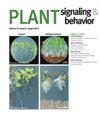Identification of differentially expressed miRNAs and their target genes in response to brassinolide treatment on flowering of tree peony (Paeonia ostii)
IF 2.8
4区 生物学
Q3 BIOCHEMISTRY & MOLECULAR BIOLOGY
引用次数: 10
Abstract
ABSTRACT Tree peony is a famous flower plant in China, but the short and concentrated flowering period limits its ornamental value and economic value. Brassinolide (BR) plays an important role in plant growth and development including flowering. There have been a large number of reports on the molecular aspects of the flowering process, but the genetic mechanism that was responsible for miRNA-guided regulation of tree peony is almost unclear. In this study, the leaves of tree peony cultivar, ‘Feng Dan’, were sprayed with different concentrations of BR, and the obvious bloom delay was found at the treatment with BR 50 μg/L. The small RNA sequencing and transcriptome sequencing were performed on the petals of tree peony under an untreated control (CK) and the treatment with BR 50 μg/L during four consecutive flowering development stages. A total of 22 known miRNAs belonging to 12 families were identified and 84 novel miRNAs were predicted. Combined with transcriptome data, a total of 376 target genes were predicted for the 18 differentially expressed known miRNAs and 177 target genes were predicted for the 23 differentially expressed novel miRNAs. Additionally, the potential miRNAs and their target genes were identified, including miR156b targeting SPL, miR172a_4 targeting AP2 and four novel miRNAs targeting SPA1, and revealed that they might affect the flowering time in tree peony. Collectively, these results would provide a theoretical basis for further analysis of miRNA-guided regulation on flowering period in tree peony.油菜素内酯处理对牡丹开花响应的差异表达mirna及其靶基因的鉴定
牡丹是中国著名的花卉植物,但花期短且集中,限制了其观赏价值和经济价值。油菜素内酯(Brassinolide, BR)在植物生长发育和开花过程中起着重要作用。关于牡丹开花过程的分子方面的研究已经有了大量的报道,但是mirna引导调控牡丹开花过程的遗传机制却几乎不清楚。本试验以牡丹品种‘凤丹’叶片喷施不同浓度的溴,在溴浓度为50 μg/L时,发现开花明显延迟。对对照对照(CK)和50 μg/L BR处理的牡丹花瓣进行了连续4个开花发育阶段的小RNA测序和转录组测序。共鉴定了22个已知的mirna,属于12个家族,并预测了84个新的mirna。结合转录组数据,共预测了18个差异表达的已知mirna的376个靶基因,预测了23个差异表达的新mirna的177个靶基因。此外,还鉴定了潜在的mirna及其靶基因,包括靶向SPL的miR156b、靶向AP2的miR172a_4和靶向SPA1的4个新型mirna,揭示了它们可能影响牡丹的开花时间。这些结果将为进一步分析mirna对牡丹花期的调控提供理论依据。
本文章由计算机程序翻译,如有差异,请以英文原文为准。
求助全文
约1分钟内获得全文
求助全文
来源期刊

Plant Signaling & Behavior
Agricultural and Biological Sciences-Plant Science
CiteScore
6.00
自引率
3.40%
发文量
111
期刊介绍:
Plant Signaling & Behavior, a multidisciplinary peer-reviewed journal published monthly online, publishes original research articles and reviews covering the latest aspects of signal perception and transduction, integrative plant physiology, and information acquisition and processing.
 求助内容:
求助内容: 应助结果提醒方式:
应助结果提醒方式:


